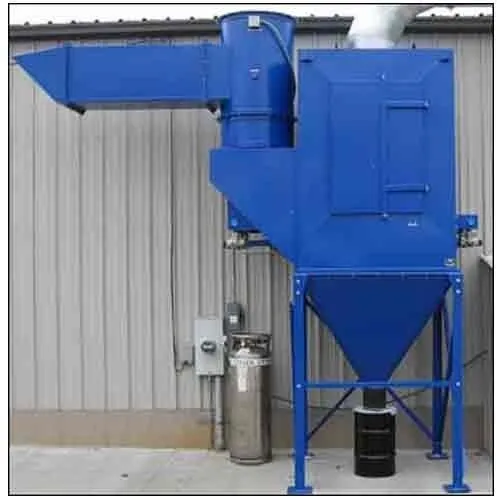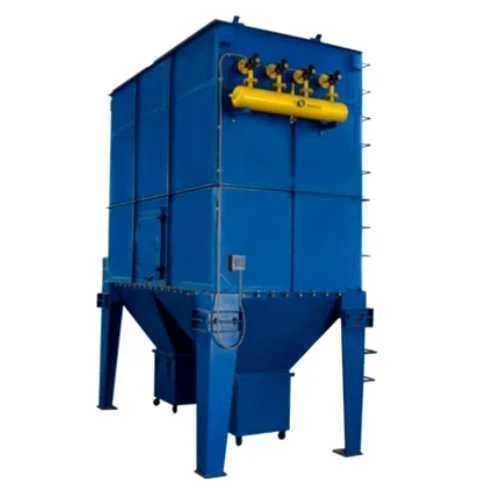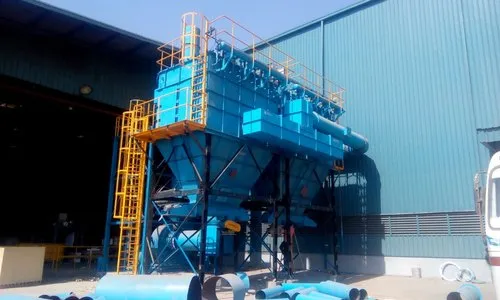Pulse Jet Bag Filter
Home / Products / Pulse Jet Bag Filter
Pulse Jet Bag Filter
A pulse jet bag filter, also known as a pulse jet dust collector, is a type of air pollution control device used to capture and remove particulate matter from industrial gas streams. It is commonly employed in a wide range of industries, including cement, steel, power generation, mining, pharmaceuticals, and food processing, where dust and particulate emissions need to be controlled. Here’s an overview of its function and construction:
Functions of Pulse Jet Bag Filter
- Particulate Capture: The primary function of a pulse jet bag filter is to capture airborne particulate matter from industrial gas streams. These particulates may include dust, smoke, fumes, and other solid particles generated during various industrial processes.
- Filtration: The dust-laden gas enters the bag filter housing, where it passes through a series of fabric filter bags. These bags act as a filter medium, trapping the particulate matter while allowing the clean gas to pass through.
- Pulse Jet Cleaning: Unlike other types of bag filters that rely on continuous or periodic cleaning mechanisms, pulse jet bag filters utilize a pulse jet cleaning system. This system periodically releases short bursts of compressed air into the filter bags, causing them to flex and expand rapidly. This action dislodges the accumulated dust cake on the surface of the bags, causing it to fall into a hopper below.
- Hopper Collection: The dislodged dust falls into a hopper located at the bottom of the bag filter housing. From there, it can be collected and disposed of properly, either manually or through automated conveying systems.
- Clean Gas Discharge: After passing through the filter bags and the dust collection hopper, the clean gas exits the bag filter housing and is discharged into the atmosphere or directed to further processing or emission control equipment.
Constructions of Pulse Jet Bag Filter
- Filter Housing: The filter bags are housed within a sturdy metal housing or casing, which is designed to withstand the operating conditions and maintain a sealed enclosure to prevent dust leakage.
- Pulse Jet Cleaning System: A pulse jet bag filter is equipped with a pulse jet cleaning system, consisting of compressed air headers, diaphragm valves, and pulse controllers. These components deliver short bursts of compressed air to the filter bags at predetermined intervals to dislodge the accumulated dust cake.
- Hopper: The dust collection hopper is located at the bottom of the bag filter housing and serves as a collection point for the dislodged dust. It may be equipped with access doors, inspection ports, and discharge mechanisms for convenient maintenance and dust removal.
- Support Structure: A pulse jet bag filter is supported by a structural framework or support structure, which provides rigidity and stability to the filter housing and facilitates installation on a concrete foundation or support platform.
- Instrumentation and Controls: Pulse jet bag filters may be equipped with instrumentation and controls, including differential pressure gauges, temperature sensors, and PLC-based control systems. These components monitor the operating parameters of the bag filter and ensure optimal performance and efficiency.
Applications of Pulse Jet Bag Filter
Pulse jet bag filters find extensive application in various industries and processes where the control of airborne particulate matter is essential for environmental compliance, worker safety, and product quality. Here are some common applications:
- Cement Production: Pulse jet bag filters are widely used in cement manufacturing plants to control dust emissions generated during raw material handling, clinker production, and cement milling processes. They help to capture particulate matter such as limestone dust, kiln dust, and cement particles, ensuring compliance with environmental regulations and maintaining air quality in surrounding areas.
- Steel and Metal Processing: In steel mills, foundries, and metal processing facilities, pulse jet bag filters are employed to capture particulate emissions generated during metal smelting, casting, welding, and grinding operations. They help to control emissions of metal oxides, fumes, and dusts, reducing air pollution and protecting workers' health.
- Power Generation: Pulse jet bag filters are used in power plants, including coal-fired, biomass, and waste-to-energy facilities, to control particulate emissions from boiler flue gas streams. They help to capture fly ash, soot, and other combustion by-products, ensuring compliance with emission standards and minimizing environmental impact.
- Mining and Quarrying: In mining operations, pulse jet bag filters are employed to control dust emissions from crushing, screening, conveying, and material handling processes. They help to capture airborne particulates such as coal dust, silica dust, and mineral particles, reducing the risk of respiratory diseases and environmental contamination.
- Pharmaceutical Manufacturing: Pulse jet bag filters are used in pharmaceutical manufacturing facilities to control dust emissions from powder handling, tablet compression, and drying processes. They help to maintain a clean and sterile environment, preventing cross-contamination and ensuring product quality and safety.
- Food Processing: In food and beverage processing plants, pulse jet bag filters are employed to control airborne dust and particulates generated during milling, grinding, mixing, and packaging operations. They help to maintain hygienic conditions, prevent product contamination, and ensure compliance with food safety regulations.
- Chemical and Petrochemical Industries: Pulse jet bag filters are used in chemical and petrochemical plants to control emissions from reactor vents, product drying, and material handling operations. They help to capture hazardous chemical dusts and vapors, protecting workers and the environment from exposure to harmful substances.
- Woodworking and Furniture Manufacturing: In woodworking facilities, pulse jet bag filters are employed to control dust emissions from sawing, sanding, and milling operations. They help to capture wood dust and airborne particles, reducing the risk of respiratory problems and maintaining a clean and safe working environment.



